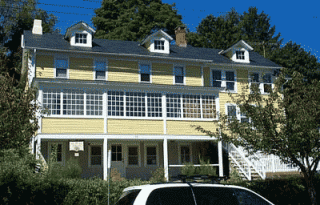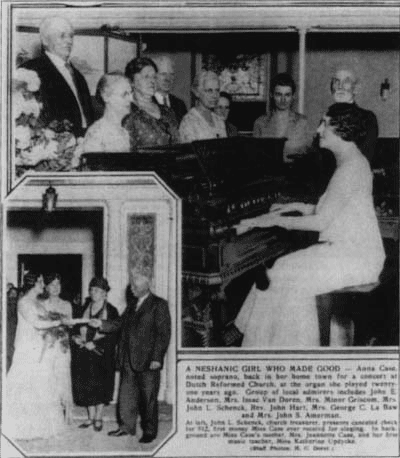Anna Case House

The original I-style house, in existence by 1873, and perhaps as early as 1860, is a 2-story house plus an embanked cellar. It is 4 bays wide, with an old addition added against the right (east) not quite flush with the main facade, that may have originated as a wing, but became two storied and then had the roof raised (revealed by two eave lines). Despite these alterations and the enclosure of a front porch with a band of windows and stairs placed at a side end, sufficient integrity remains such that it is a contributing property to the historic district.
Anna Case, who became an outstanding opera singer was born at 15 East Main Street, on October 29, 1889. Her father was the local blacksmith. When she was young, her family moved to South Branch, Somerset County. She assisted her father by collecting bills and cleaning up his shop. Anna seemed to have a natural gift for music, and at 15 she became the organist and choir director at Neshanic Dutch Reformed Church, earning $12 a month. She had no formal piano or organ lessons. Anna Case began to take voice lessons from Catherine Opdyke of Somerville, until Opdyke revealed that she did not have the capacity to teach Case and took her to Madame Ohrstrom-Renard in New York. On November 20, 1909, at the age of 20, Anna debuted as a cast member in "Lohengrin" at the Metropolitan Opera. Six months later her first solo came in the opera "Werther." Anna Case was the first American signer at the Metropolitan who had no European training or international reputation. She remained at the opera house from 1909 until 1920, and traveled on concert tours extensively. Case married Clarence Mackay in 1931. He was a millionaire who had founded a postal telegraph system, which later merged with Western Union. They had no children (Mackay died in 1938), but she became stepmother to his three children from a previous marriage. One of his daughters, Ellen, married Irving Berlin. Although she retired at the time of her marriage, she continued to write songs. None of her 50 songs is familiar today. There is a plaque dedicated to Anna Case in the lobby of the Metropolitan Opera House.

Anna Case is shown here playing organ at the Dutch Reformed Church in Neshanic at a recital in 1930. The organ was one of many placed in area churches by the Andrew Carnagie Foundation. (Photograph from the Newark Sunday Call, courtesy of June Stryker Amerman)

